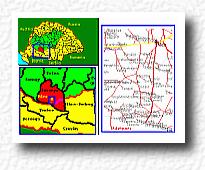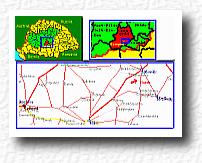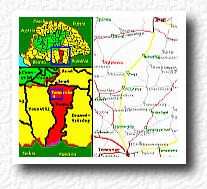![]()

![]()

 |
 |
| The
family name 'Majláth' has no meaning in either
Hungarian or Rumanian. One must look to the Slavic
languages from which family names such as Bogát, Szólát,
Mikszáth, and Bajzát come from. According to Dr. Karácsonyi János, if you split the name 'Majlát' into the syllables 'maj' and 'lat', then 'maj' means 'my or mine' in English or 'enyém' in Hungarian signifying possession. The second syllable 'lat' has its roots in the Russian or southern Slavic word for armour or steel. In northern Slavic this word refers to some kind of wooden structure that protects a house. In earlier or older Slavic languages the name 'Majlát' means 'my armour' or 'my defender'. |
A
Majláth szó a román (és Magyar)
nyelvben semmit sem jelent és abból meg nem fejthető.
Másrészt azonban látjuk, hogy a szláv nyelvekben, Bogát,
Szólát, Mikszáth, Bajzát családnevek, brkat, krilat
melléknevek fordulnak elő. Ez arra kényszerit bennünket,
hogy a Majláth név eredetét a szláv nyelvekben keressük,
annál is inkább, mert a bolgár-szlávoknál Angelát
családnév, a kisoroszoknál Vihorlát hegynév találhatók
és ezek utolsó szótagukban a Majláth névvel egyeznek. Dr. Karácsonyi János azt írta hogy ha már most a Majlát nevet is széttagoljuk moj-ra, és lát-ra, ennek is meg kapjuk az értelmét. 'Moj' ugyanis annyit tesz mint 'enyém', 'lat' pedig az orosz- és délszlávban páncélt, az északi szlávban pedig lécet, vagy deszkát, tehát házvédő eszközt jelent. 'Majlát' tehát az ó szlávban annyit tett, mint 'páncélom' 'védőm'. |
![]()

 |
|
| In Nagy Iván's work on the Families of Hungary, Lampert István (descended from the Akus race) and his sons Miklós and Moinót (whom Bonfin wrote as Majlát) were murdered in 1131 at a congregation in Arad county. From this Moinót or Majláth originated the Majláth family according to Pethő Gergely. | Nagy Iván írja hogy az Akus nemből
származott Lampert
István, és fiai Miklós és Moinót, (kit Bonfin Majlát-nak ír) 1131-ben az aradi gyűlésen, mint II. Béla
király vakságának okozói ölettek meg. Ezen nevezett Moinót, vagy Majláth-tól származtatik a Majláth család, mint Pethő Gergely megírja. |
Bonfin, Ans. Hist. és Thuróczy
Cronicon.
Pethő Gergely, Magyar Krónika,
Kassán 1729. 34 pages.
I do not have access to these references. Who and what were the Akus race?
J. Siebmacher mentions that the "Malath" name was first written in 1335 by Malath Mester, the son of Benedict. The name appears in 1413 as used by an András who was called "Malath" and a citizen of the historical Hungarian county of Pozsony (now Bratislava, Slovakia).
In 1415, the name "Mayláth" was used by someone called Dragomir. Up to this time the Mayláth name was only a nickname and had not yet been adopted as a family name.
It was not until the 15th. Century that the Maylad de Szunyogszeg family appeared in the county of Fogaras, Erdély of historical Hungary now Transylvania, Rumania.
![]()
A family may get its name by various obvious means: (a) a deliberate change of name or by means of adoption; (b) from a place name; (c) from a trade or a profession; (d) and the least likely source is direct descent from some family belonging to the nobility.
It is possible that some of us got the family name from a place or village where our ancestors lived for a long time. I have identified at least four places with the Majláth name; one in Felvidék (now Slovakia); one in Baranya and one in Csongrád counties of modern Hungary; and one in Temes county, Erdély of historical Hungary (now Transylvania, Rumania).

 The first one was Presztavnik a Tóth ethnic community in the
historical Hungarian county of Bars. It had its name changed in 1890 to
Mailáth in honour of a past county
governor, Mailáth István.
After 1920, the village name was changed to Prestavlky now in Slovakia. The village is
about 7 Km. from Garamszentkereszt in Hungarian or "?iar nad
Hronom" in Slovakian. The village name of Mailáth existed
for too short a time for many families to adopt this new name and
spread over Hungary and the world. Click on the map on the left
for a larger view.
The first one was Presztavnik a Tóth ethnic community in the
historical Hungarian county of Bars. It had its name changed in 1890 to
Mailáth in honour of a past county
governor, Mailáth István.
After 1920, the village name was changed to Prestavlky now in Slovakia. The village is
about 7 Km. from Garamszentkereszt in Hungarian or "?iar nad
Hronom" in Slovakian. The village name of Mailáth existed
for too short a time for many families to adopt this new name and
spread over Hungary and the world. Click on the map on the left
for a larger view.

 The
second is Mailáthpuszta, Baranya county in modern Hungary. Puszta
means 'prairie' or 'plain'. This place is about 36 Km. from the
city of Pécs (pronounced Peach). I do not know
how the place got its name or when. Some families may have gained
their name from this place. Click on the map on the left for a
larger view.
The
second is Mailáthpuszta, Baranya county in modern Hungary. Puszta
means 'prairie' or 'plain'. This place is about 36 Km. from the
city of Pécs (pronounced Peach). I do not know
how the place got its name or when. Some families may have gained
their name from this place. Click on the map on the left for a
larger view.

 The
third is Nagyér, Csongrád county in modern Hungary. This
village used to be called Nagymajlát and Majláth after Lord Chief Justice Majláth
György. This place was originally in the historical county of Csanád which was merged with Csongrád
county. It received its present name of Nagyér in 1952 and is 25 Km. from Makó and 46 Km. from Szeged. Click on the map on the left for a
larger view.
The
third is Nagyér, Csongrád county in modern Hungary. This
village used to be called Nagymajlát and Majláth after Lord Chief Justice Majláth
György. This place was originally in the historical county of Csanád which was merged with Csongrád
county. It received its present name of Nagyér in 1952 and is 25 Km. from Makó and 46 Km. from Szeged. Click on the map on the left for a
larger view.

 The
fourth was Majláthfalva, Temes, Erdély, Hungary now called Mailat in Rumania. Falva means 'the
village of'. It is about 23 Km. from Arad and 33 Km. from Temesvár,Timişoara in Rumania.I do not know
how the village got its name or when. Some families may have
gained their name from this place. Click on the map on the left
for a larger view.
The
fourth was Majláthfalva, Temes, Erdély, Hungary now called Mailat in Rumania. Falva means 'the
village of'. It is about 23 Km. from Arad and 33 Km. from Temesvár,Timişoara in Rumania.I do not know
how the village got its name or when. Some families may have
gained their name from this place. Click on the map on the left
for a larger view.
There is another place called Mailáthgárdony and maybe others as well.
![]()
![]()
Not all names listed here are necessarily related, but they are very similar. Some possible versions of the Majláth name that have been observed:
| Australia | Mailath | Majlath | |||||
| Austria | Majlath | ||||||
| Chile | Mailath | ||||||
| France | Maéilat | Maillat | Maillet | Maillette | |||
| Germany* | Majlath | Mailáth | |||||
| Hungary | Mailáth | Mailát | Majláth | Majlát | Mayláth | Meláth | |
| Rumania | Majlat | ||||||
| Slovakia | Majlat | Majlath | Majlathova | ||||
| USA | Mailat | Mailath | Maylath | Maylat | Maylathon | Maylad | Milot |
| Other | Majláta |
No doubt there are others. Marc Majlath
kindly pointed out there were Majlaths in Germany also.
Thanks to Thomas Milot (USA)
for pointing out another possible variation of the name.
The county coat-of-arms are from the site by András Szeitz and Don Mabry.
![]()
Last updated 22 December 2005
Maintainer T. Majlath
![]()